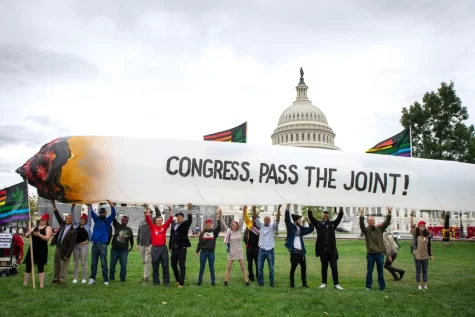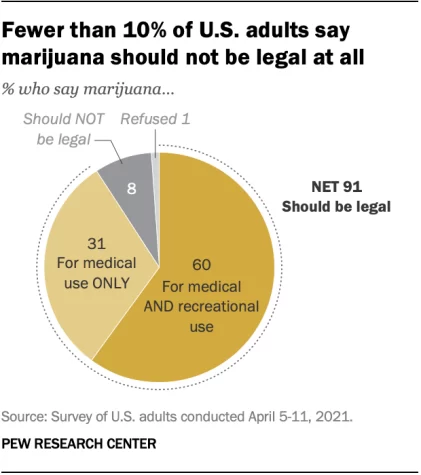
Reaghan Mulligan | Newsroom Manager
April 20, 2022
The use of medical marijuana is legal in thirty-eight states and the District of Columbia. Recreational cannabis is legalized across eighteen states. A wave of legalization began with California in 1996, with many states following suit, yet no decisive legislation has passed at the federal level.

Ninety-one percent of American adults agree that marijuana should be legal to some extent, thirty-one for medical use only and sixty percent for both medical and recreational use. That leaves only eight percent of adults that conclude cannabis should not be legal in any form.
If a significant portion of the nation agrees—to some conclusion—that marijuana should be legal, why is there such disparity amongst the states and even no jurisdiction at the federal level?
In early April, the House of Representatives made a mainly partisan 220-204 vote to end the prohibition of marijuana at a federal level. The chamber discussed the Marijuana Opportunity, Reinvestment, and Expungement (MORE) Act developed by House Judiciary Chairman Jerrold Nadler (D-NY). A replication of MORE similarly passed through the House in 2020, but was unable to move through the Senate—a shared concern for this recent legislation.
The bill would remove marijuana from the list of federally banned drugs created by the Controlled Substances Act (CSA), however states would maintain jurisdiction on state-by-state legalization and a general responsibility for cannabis regulation.
Three amendments were proposed for the legislation, only two of which earned majority approval:
Democratic Representative Josh Gottheimer of New Jersey offered a referendum that would provide ten million dollars in funding for the National Highway Traffic Safety Administration in order to investigate means to determine if a driver is operating a vehicle under the influence of cannabis. This action was approved, 243-172.
Democratic Representative Conor Lamb of Pennsylvania proposed an enforcement on the National Institute for Occupational Safety and Health to conduct research on the effects of legalizing recreational marijuana in the workplace and the creation of updated practices and regulations. It was approved with a 234-189 majority.
The third revision, by Democratic Representative Jamie Raskin of Maryland, would compel federal agencies to analyze security clearance denials and prohibit cannabis from being a reason for denying clearance. This was rejected, 209-214.
Among the many important reformation initiatives established by the MORE Act, highlights include the plan to clear past convicts of marijuana possession charges as well as the potential to receive a form of compensation via public benefits and a redetermining of incarceration for those currently serving a sentence for cannabis.
While a person in California can enjoy a regulated amount of recreational marijuana without repercussions, another—Sara Rodriquez of San Bernardino County, CA—has a lasting felony on her record for marijuana possession almost twenty years ago. Despite the recent legality of cannabis both medically and recreationally in California, Rodriquez and thousands more maintain a mark on their record that can impact their ability to obtain employment, housing, and other situations where a background check may be required.
Although promises of clearing non-violent possession charges are upheld, many are delayed and potentially never completed, leaving thousands of people with abiding consequences of a punishment already served for a modernly legal ‘crime.’
The propositions for the MORE Act appear to directly combat the lasting effects of the War on Drugs in order to reinstate communities that were disproportionately affected, such as poorer neighborhoods or those with a high minority population.
“[Ending marijuana prohibition] would make [obtaining weed] safer for people,” senior Jenna Garvey said. “By legalizing [cannabis] and educating people about it, rather than telling people to ‘just not do it’ and then punishing them, we can ensure that others are being more cautious and responsible.”
The MORE Act would impose a federal tax on marijuana products, beginning at five percent and raising to eight percent after five years of implantation. Money collected from these taxes would be placed in a “Opportunity Fund”, with half of the revenue going to a “Community Reinvestment Grant Program”—which would fund community organizations in order to provide outreach programs for neighborhoods impacted by the War on Drugs—ten percent going to treatment programs, and forty percent to support the Small Business Administration (SBA).
“Federally legalizing marijuana is only impactful if paired with proper support for communities that were marginalized because of their use,” senior Bethany Padilla said.
The MORE Act, despite its conclusive plans to progress marijuana legalization, faces a number of opponents and obstacles that may bar it from passing in the Senate. In order to become law, it would require a majority vote in the Senate, calling for a more bipartisan opinion on the bill which—given its party-line vote in the House—may be unlikely.

Leave a Reply